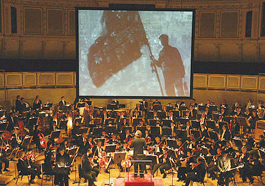home | metro silicon valley index | music & nightlife | band review

PICTURING MUSIC: The symphony's Stravinsky program featured a multimedia show.
The Rite Stuff
Symphony Silicon Valley looked at Stravinsky's 'The Rite of Spring' from all sides last weekend
By Scott MacClelland
THE CASE is often made that Igor Stravinsky's Le sacre du printemps (The Rite of Spring) redefined and redirected the course of 20th-century music. At the end of his life, Stravinsky reflected that while he heard the music in his mind's ear, he was only the vessel through which it came into existence. Like other dominant musical geniuses of his generation, Stravinsky sought inspiration among the ancient traditions of his native land. Similarly, he turned to those who knew more about the subject than he did, directing his attention to Nicolai Rerikh (Nicholas Roerich), a colorful Russian from St. Petersburg with artistic, philosophical, archeological and literary credentials, who fancied himself an expert on early Russian folklore and music.
Rerikh's influence on Stravinsky and Le sacre du printemps would prove to be profound. While none of this background found its way into annotator Beth Fleming's program notes for its weekend concert, Symphony Silicon Valley compensated with a one-hour pre-performance "show and tell" that filled in nearly all the blanks and showed unequivocally how deeply indebted the composer was to his mentor. (It was Rerikh's stage designs, with their ancient Russian motifs, that contributed significantly to the scandalous success of Le sacre's 1913 premiere in Paris.)
Joining guest conductor Martin West and the orchestra—for the Sunday matinee—were narrator Amy Hansen, actor Kevin Kennedy and folk musician Clark Welsh in a "Beyond the Score" production that projected photos of turn-of-the-20th-century rural Russia and Rerikh's designs as well as audio snippets of folk songs and choral dances from that same era. After each of those audio clips and the "primitive" tunes played by Welsh on folk instruments, West and the orchestra read through passages of the Stravinsky score that recycled those tunes in vivid orchestral garb and, often, highly complex textures. The program was organized with exceptional clarity and remained focused on the great work and its origins (paying no heed to the event of its infamously riotous reception in Paris).
According the narrative material, Lithuania turned out to provide a particularly valuable repository of pre-Christian musical and dance rituals, being the last among the Nordic provinces to embrace Christianity, and with cultural roots in the Stone Age. That may explain why Stravinsky started referring to his "lapidary rhythms" that infest Le sacre (as well as Les noces and a few other of his "primitive" folkloric works). Stravinsky was nothing if not a master of syncopation, in every possible meaning of that word—what came to be known as his "asymmetry racket." His lapidary rhythms are at their most sensational intensity in Le sacre. One surmises that in his latter-day recollections he must have wondered in amazement at how on earth he did it. Yet, as the 90-piece orchestra returned from intermission to play it straight through, the great work demonstrated once again its astonishing coherency despite cacophony and complexity.
History has smiled far more favorably upon the ballet's music than the choreography itself (whose original version gets revived from time to time). For that reason, and notwithstanding a lot of excellent solo playing in this case, the performance too often fell short of the precision and crisp articulation the score demands.
Send a letter to the editor about this story.
|
|
|
|
|
|